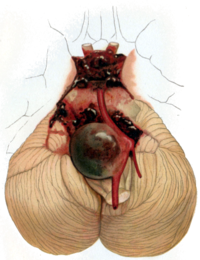
Photo from wikipedia
PURPOSE To analyze and compare safety and efficacy of different endovascular treatment modalities for unruptured intracranial large or giant aneurysms. METHODS We retrospectively reviewed 126 consecutive patients with 128 large… Click to show full abstract
PURPOSE To analyze and compare safety and efficacy of different endovascular treatment modalities for unruptured intracranial large or giant aneurysms. METHODS We retrospectively reviewed 126 consecutive patients with 128 large (15-24 mm) or giant (≥25 mm) aneurysms that were treated with different endovascular procedures between January 2014 and February 2017. We compared clinical and angiographic outcomes and occurrence of technical events among 3 treatment modalities. RESULTS Complete occlusion at last follow-up was achieved in 65.6%, 90.5%, and 72.0% of aneurysms in stent-assisted coiling, parent artery occlusion, and Pipeline embolization device (PED) groups (P = 0.119). Complete occlusion rate at 6-month follow-up (odds ratio = 1.81, P = 0.396) and at last angiographic follow-up (odds ratio = 3.64, P = 0.123), was not superior with parent artery occlusion compared with PED. Retreatment rate was significantly different among all groups (P < 0.001); the rate was highest in the stent-assisted coiling group (21.9%). Rates of hemorrhagic events and ischemic events were not significantly different among groups (P = 0.581). Mass effect exacerbation was more frequently seen in the stent-assisted coiling group (24.4% vs. 7.7% and 3.3%, P = 0.004). Major complication rate was higher in the parent artery occlusion group compared with the PED group, but the difference was not statistically significant (19.2% vs. 16.4%, odds ratio = 1.21, P = 0.763). Rate of technical events was significantly different in the 3 groups (P = 0.0437), and technical events occurred more often in the PED group (18.0%). CONCLUSIONS For large and giant aneurysms located in the internal carotid artery, outcome for endovascular treatment remains poor, even with the introduction of PED.
Journal Title: World neurosurgery
Year Published: 2019
Link to full text (if available)
Share on Social Media: Sign Up to like & get
recommendations!